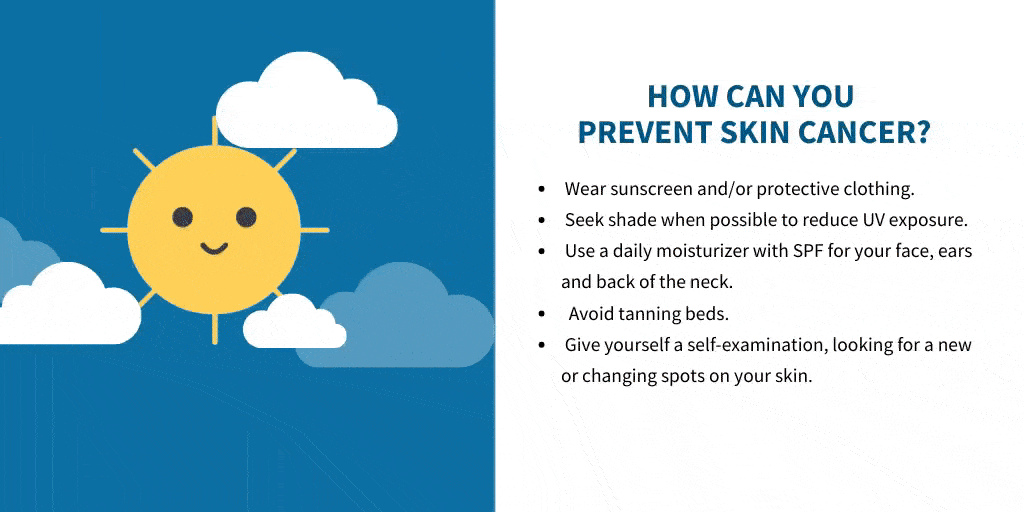Washington University School of Medicine skin cancer experts want everyone to know that skin cancer is preventable. Following helpful tips, such as wearing broad spectrum SPF sunscreen, seeking shade and avoiding tanning beds can help a person reduce their risk of developing skin cancer.
Despite its preventability, skin cancer is the most common type of cancer, and 1 out of 5 Americans will develop skin cancer by age 70, according to the Skin Cancer Foundation.
“Skin cancer is treated by multiple physicians in a multidisciplinary, collaborative effort,” says Ryan Fields, MD, Section Chief of Surgical Oncology. Dermatologists, Oncologists, and Surgeons work collaboratively to educate the public about the types of skin cancer and how these cancers are treated by the expert Skin Cancer Team at the School of Medicine and Siteman Cancer Center.
The Skin Cancer Team answers some common questions about skin cancer types and treatments below.

What are the types of skin cancer?
Lynn Cornelius, MD, Division Chief of Dermatology
There are several types of skin cancer.
The most common types are non-melanoma skin cancers (NMSC), such as basal cell and squamous cell carcinoma. The majority of skin cancers begin in the epidermis, which is predominantly made up of three kinds of cells: squamous cells, basal cells and melanocytes. The most serious forms of skin cancer are melanoma and Merkel cell carcinoma.
Basal Cell Carcinoma
Basal cell carcinoma is the most common type of skin cancer, and rarely metastasizes or spreads. About 8 out of 10 skin cancers are basal cell carcinomas. They are usually found on skin exposed to sunlight, and may appear as a small white or flesh-colored bump that grows slowly and may bleed.
Squamous Cell Carcinoma
Squamous cell carcinoma is the second most common skin cancer. This type of skin cancer has a low but not negligible incidence of metastases, spreading in approximately 2% of cases. Usually, squamous cell carcinoma occurs on parts of the skin that are exposed to long periods of sunlight, such as the face, ears, lips, neck, arms and backs of hands. This cancer may appear as a firm red bump, a scaly red patch, an open sore, or a wart that may crust or bleed easily.
Merkel Cell Carcinoma
Merkel cell carcinoma is a more uncommon type of skin cancer that can grow quickly and can be hard to treat if it spreads beyond the skin. Merkel cells are very close to nerve endings in the skin and are thought to be a type of neuroendocrine cell because they share some features with nerve cells and hormone-making cells. This form of cancer usually appears as a single firm, raised red or violet lump.
Melanoma
Although less common than squamous cell or basal cell cancers, melanoma is a more aggressive cancer and is more likely to grow and spread if not diagnosed and treated early. Melanomas develop from melanocytes, the pigment-making cells of the skin. Melanocytes can also form non-cancerous moles. Melanoma can occur anywhere on the body, including areas that are not exposed to the sun. A common sign of melanoma is a mole that changes in size, shape or color.
How does skin cancer spread?
Jesse Keller, MD, Assistant Professor of Medical Oncology
The spread of a cancer outside of its place of origin, whether to an adjacent lymph node or potentially another organ, is a very serious event and the key driver of prognosis for patients with skin cancers.
The length of time that it takes for skin cancers to spread depends on several factors. It is very important to note that every cancer is different and there are no exact rules on how long it takes a cancer to spread. However, the key factor in how likely something is to spread is the type of skin cancer. For the major types of skin cancers, melanoma has the highest risk in terms of potential for spread beyond the skin. Basal cell and squamous cell skin cancers very rarely spread beyond the skin, and usually only if they become quite large. Melanoma and Merkel cell carcinoma, however, have the potential to spread very quickly or to grow in place for a long time and never spread. Moreover, I have seen melanoma spread through the body many years after a small lesion was caught at an early stage.
The key here is that you should check your skin regularly, and that skin cancers should be addressed with your dermatologist or doctor as soon as possible. In general, the sooner we remove the cancer, the better.
What kind of doctor should I see if I might have skin cancer?
M. Laurin Council, MD, Associate Professor of Dermatology
A board-certified dermatologist can evaluate a new lesion to determine whether or not it needs a biopsy. If you live in an area without a board-certified dermatologist, your primary care physician may be able to do the same. You can request a “full-body skin examination” to have your skin lesions checked—even ones on your back or the backs of your legs where you may not be able to typically see. If you have had a previous skin cancer, your doctor is likely to recommend that you repeat this several times a year.
What are the types of treatments for skin cancer?
Jesse Keller MD, Assistant Professor of Medical Oncology
The vast majority of skin cancers are cured with appropriate treatment.
For those patients who present with a cancer that is potentially curable, there are several strategies that can be used to remove the cancer, and the technique depends largely on the type of skin cancer that is being treated.
Squamous and basal cell skin cancers are usually treated with less invasive measures than melanoma skin cancers. Melanoma treatment usually requires a trained surgeon who will perform an excision with a wide margin and potentially even sample lymph nodes to assess if there has been spread.
Rates of cure are complicated and depend on many clinical and biological factors. In general, with appropriate treatment and management, cure can be expected in most cases. Unfortunately, sometimes skin cancers are caught late, or they grow and move very quickly, hampering our ability to cure patients. In those cases, however, we have been very lucky to have made substantial gains recently in the treatment of advanced skin cancers. These scientific advances have dramatically changed life for many patients who live with advanced skin cancers, and given hope to those who previously faced a very difficult disease.
David Chen, MD, PhD, Division of Dermatology
If you do develop skin cancer that is amenable to surgery, this is still usually the best treatment.
For patients whose skin cancers have spread, or otherwise cannot be treated by surgery, the options for therapy are rapidly increasing. Two relatively new categories of therapy have revolutionized skin cancer treatment—those that target the cancer directly and those that harness the power of the immune system to fight cancer.
Targeted therapies derive from our increasing knowledge of how tumors arise and what machinery they depend on to survive. Genetic sequencing revealed mutations in some of the “drivers” of skin cancers, including BRAF (melanoma) and PTCH1 (basal cell carcinoma), both of which have targeted therapies available. In order to survive, cancers often have evolved mechanisms to evade detection and destruction by the body’s immune system. Immunotherapy aims to “take the brakes” off the immune system to fight cancer.
If a skin cancer has spread, most therapies are given in a way that potentially affect the entire body. A unique feature of skin tumors—due to their accessibility—has given rise to a newer category of therapy is what we know as intralesional therapies—medicines injected into the tumor itself. The goal of these therapies is to cause tumor destruction of the injected tumor but also to engage the immune system by altering the tumor “microenvironment.” Injection of medicine directly into tumors may mitigate some of the side effects seen in patients who receive medicines that affect the entire body. There are studies underway to test the effectiveness of these medicines when given in combination with other immunotherapies.
What sets Washington University and Siteman Cancer Center apart?
Ryan Fields, MD, Section Chief of Surgical Oncology
The Skin Cancer Team at the School of Medicine and Siteman Cancer Center consists of dermatologists, surgeons, medical oncologists, pathologists, nurses, councilors and caregivers and patients. Depending on the type and stage of skin cancer, the team has several treatment options available, including surgical excision, immunotherapy, chemotherapy and targeted therapy individualized to that patient’s case.
The goal of this team is to provide a full range of cancer diagnosis and treatment options led by specialists at the top of their field when needed, and to educate and monitor patients to reduce the risk of developing skin cancer.
This is such a center of excellence for skin cancer. We have a team who focuses only on skin cancer, and that’s their specialty. I like to run, I like to bike ride, I like to spend time with my kids in the back yard. We don’t want people to avoid those kinds of activities. We just want people to be sensible about not getting sunburns, not getting to the point where you’re looking at yourself in the mirror and see that you have a “farmer’s tan,” which probably means you’re not using sunblock as you should. If you do come to the Skin Cancer Team with a melanoma or other skin cancer, you’re getting world-class leaders in the field who are involved in national and international treatment recommendations, cutting-edge clinical trials and research on new therapeutics and diagnostics and prevention techniques. You just get the best of the best.
More information on skin cancer prevention, detection and treatment, as well as a complete listing of physicians on the Skin Cancer Team, is available at Siteman Cancer Center.
